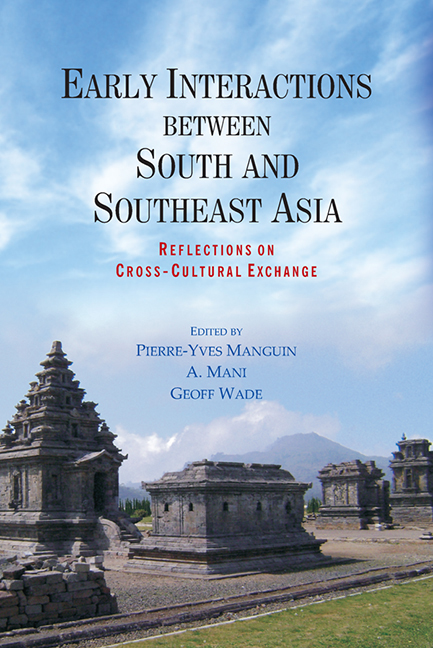Book contents
- Frontmatter
- Contents
- FOREWORD
- Preface
- Introduction
- PART I New Archaeological Evidence from South Asia and Southeast Asia
- 1 Central Vietnam during the Period from 500 BCE to CE 500
- 2 Ban Don Ta Phet and Khao Sam Kaeo: The Earliest Indian Contacts Re-assessed
- 3 Preliminary Study of Indian and Indian Style Wares from Khao Sam Kaeo (Chumphon, Peninsular Thailand), Fourth-Second Centuries BCE
- 4 Early Contacts between India and the Andaman Coast in Thailand from the Second Century BCE to Eleventh Century CE
- 5 The Batujaya Site: New Evidence of Early Indian Infl uence in West Java
- 6 Continuity and Change in South Indian Involvement in Northern Sumatra: The Inferences of Archaeological Evidence from Kota Cina and Lamreh
- 7 South Asia and the Tapanuli Area (North-West Sumatra): Ninth-Fourteenth Centuries CE
- 8 Emergence of Early Historic Trade in Peninsular India
- 9 Contacts between India and Southeast Asia in Ceramic and Boat Building Traditions
- 10 Marine Archaeological Investigations along the Tamil Nadu Coast and their Implications for Understanding Cultural Expansion to Southeast Asian Countries
- PART II Localisation in Southeast Asia
- LIST OF CONTRIBUTORS
- INDEX
2 - Ban Don Ta Phet and Khao Sam Kaeo: The Earliest Indian Contacts Re-assessed
from PART I - New Archaeological Evidence from South Asia and Southeast Asia
Published online by Cambridge University Press: 21 October 2015
- Frontmatter
- Contents
- FOREWORD
- Preface
- Introduction
- PART I New Archaeological Evidence from South Asia and Southeast Asia
- 1 Central Vietnam during the Period from 500 BCE to CE 500
- 2 Ban Don Ta Phet and Khao Sam Kaeo: The Earliest Indian Contacts Re-assessed
- 3 Preliminary Study of Indian and Indian Style Wares from Khao Sam Kaeo (Chumphon, Peninsular Thailand), Fourth-Second Centuries BCE
- 4 Early Contacts between India and the Andaman Coast in Thailand from the Second Century BCE to Eleventh Century CE
- 5 The Batujaya Site: New Evidence of Early Indian Infl uence in West Java
- 6 Continuity and Change in South Indian Involvement in Northern Sumatra: The Inferences of Archaeological Evidence from Kota Cina and Lamreh
- 7 South Asia and the Tapanuli Area (North-West Sumatra): Ninth-Fourteenth Centuries CE
- 8 Emergence of Early Historic Trade in Peninsular India
- 9 Contacts between India and Southeast Asia in Ceramic and Boat Building Traditions
- 10 Marine Archaeological Investigations along the Tamil Nadu Coast and their Implications for Understanding Cultural Expansion to Southeast Asian Countries
- PART II Localisation in Southeast Asia
- LIST OF CONTRIBUTORS
- INDEX
Summary
INTRODUCTION
This paper summarises the evidence from Ban Don Ta Phet (henceforth BDTP) in the light of recent studies on the site itself as well as of new discoveries in Thailand, and makes special reference to the analyses of metal, glass and hard stone artefacts from the excavations at Khao Sam Kaeo (henceforth KSK) in Chumphon Province, Peninsular Thailand (Fig. 2.1). The latter is the project of a joint French-Thai team with a strong focus on technological analyses of craft productions involved into Trans-Asiatic exchange. Over thirty years ago a series of excavations commenced at BDTP, an Iron Age burial site in Kanchanaburi Province (west-central Thailand) which yielded, what at the time, was the earliest clear and dated evidence for contacts between Southeast Asia and India. A carnelian lion pendant provisionally identified by Glover (1990a) as a representation of Buddha as Sakyasima (Lion of the Sakya Clan) in the late centuries before the Christian Era, was interpreted as a precursor to the introduction of Buddhism into Southeast Asia. New data and analyses enable us to augment and revise previous interpretations of BDTP, to compare and contrast it to KSK, and to raise new issues on the timing and nature of early exchange between South and Southeast Asia and across the South China Sea.
This site was first excavated in 1975 with subsequent investigations up to 2000 by teams from the Archaeological Division of the Fine Arts Department of Thailand (henceforth FAD) and the Institute of Archaeology, University College London and many reports, booklets, journal and conference articles have been published over the years in Thai and English (Glover 1980, 1983, 1990; Glover et al. 1984 among others). New studies of the site and renewed analyses of the finds (Srinivasan and Glover 1995; Bellina 2007; Woods 2002; Lankton and Dussubieux 2006; Lankton pers. comm. May 2007) and comparisons with the excavations at KSK (Bellina and Silapanth 2006, 2008) both deepen, and to some extent change, our understanding of BDTP and allow us to raise new issues on the timing and nature of early exchange between South and Southeast Asia and across the South China Sea.
- Type
- Chapter
- Information
- Early Interactions between South and Southeast AsiaReflections on Cross-Cultural Exchange, pp. 17 - 46Publisher: ISEAS–Yusof Ishak InstitutePrint publication year: 2011



